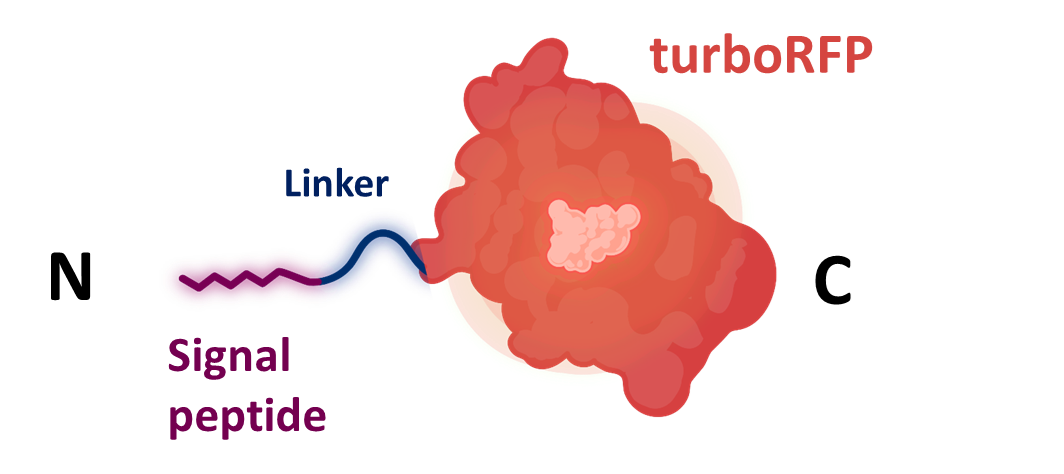Part:BBa_K4365006
Signal peptide of MPGI from Magnaporthe grisea
MPGI is a protein found in Magnaporthe grisea and belongs to a family of highly secreted proteins called hydrophobins. The signal peptide from the protein led to turboRFP secretion in Saccharomyces cerevisiae.
| ID | Source | Species | Prediction coefficient [1] | turboRFP secretion | |
|---|---|---|---|---|---|
| sp1 | BBa_K4365006 | MPGI | Magnaporthe grisea | 0.9562 | Yes |
| sp2 | BBa_K4365007 | RodA | Aspergillus nidulans | 0.9553 | Yes |
| sp3 | BBa_K4365008 | HYPI | Aspergillus fumigatus | 0.9703 | No |
| sp4 | BBa_K4365009 | SsgA | Metarhizium anisopliae | 0.9126 | No |
| sp5 | BBa_K4365010 | HCF-4 | Cladosporium fulvum | 0.9126 | Yes |
| sp6 | BBa_K4365025 | HCF-5 | Cladosporium fulvum | 0.9234 | NA |
| sp7 | BBa_K4365026 | CCG-2 | Neurospora crassa | 0.9566 | NA |
| sp8 | BBa_K4365011 | HCF-1 | Cladosporium fulvum | 0.6850 | Yes |
| sp9 | BBa_K4365027 | HCF-2 | Cladosporium fulvum | 0.8144 | NA |
| sp10 | BBa_K4365012 | HCF-3 | Cladosporium fulvum | 0.7934 | No |
| sp11 | BBa_K4365013 | SC3 | Schizophyllum commune | 0.6327 | No |
| sp12 | BBa_K4365014 | ABH3 | Agaricus bisporus | 0.9458 | Yes |
| sp13 | BBa_K4365028 | COH1 | Coprinus cinereus | 0.8545 | NA |
| sp14 | BBa_K4365015 | FBH1 | Pleurotus ostreatus | 0.3367 | Yes |
| sp15 | BBa_K4365016 | Aa-PRI2 | Agrocybe aegerita | 0.6356 | Yes |
| sp16 | BBa_K4365033 | Hyd-Pt1 | Pisolithus tinctorius | 0.8352 | NA |
| sp17 | BBa_K4365017 | HFBI | Trichoderma reesei | 0.9851 | Yes |
| sp18 | BBa_K4365018 | HFBII | Trichoderma reesei | 0.6862 | Yes |
| sp19 | BBa_K4365019 | α-mating factor | Saccharomyces cerevisiae | 0.9988 | Yes |
- ↑ José Juan Almagro Armenteros et al. (2019) SignalP 5.0 improves signal peptide predictions using deep neural networks Nature Biotechnology, 37, 420-423, doi: 10.1038/s41587-019-0036-z
Sequence and Features
- 10COMPATIBLE WITH RFC[10]
- 12COMPATIBLE WITH RFC[12]
- 21COMPATIBLE WITH RFC[21]
- 23COMPATIBLE WITH RFC[23]
- 25COMPATIBLE WITH RFC[25]
- 1000COMPATIBLE WITH RFC[1000]
Usage and Biology
Secretion signal peptides can be fused to a protein to direct it through the secretory pathway out of the cell [1]. Such secretion of recombinant proteins facilitates the protein purification process and the removal of GMOs [2]. However, commonly used signal sequences like the *S. cerevisiae* alpha-factor prepro-peptide K4365019 and the HSP150, are very long [2][3] which makes their use in genetic constructs limited. K4365006 as a part of the collection of signal peptides represents a shorter sequence that could be inserted into the gene of interest simply by PCR and could display higher secretion efficiency.
The sequences of the hydrophobic signal peptide was collected from literature [4] and was extracted via analysis of their sequence using the SignalP - 5.0 signal peptide predictor tool [5].
Identified sequence was codon-optimized for S. cerevisiae using the codon optimization tool on GenScript. Then it was synthesized by IDT as a gBlock together with a flexible glycine linker (K4365005) and the turboRFP gene (K4365020) [6].
Hydrophobins
Hydrophobins are a group of small (~100 amino acids) proteins that are expressed in ascomycetes and basidiomycetes, which are very efficiently secreted [2].
After secretion from the fungus, they can assemble on the cell walls to form a hydrophobic coating. For this reason, the functions of hydrophobins are related to cell surface activity. For example, they can cover hyphae so the surface tension can be lowered and the hyphae can breach the water/air interface, thus escaping from the aqueous environment and growing into the aerial hyphae [7]. They also mediate the adhesion of the hyphae to hydrophobic surfaces such as in the case of pathogen-host interaction or symbiosis, as observed in lichens and in ectomycorrhizae (the symbiotic relationship between a fungal symbiont and the roots of a plant) [7]. Hydrophobins also form a hydrophobic sheath to protect the surface of conidia, spores, and caps of fungi against wetting and desiccation [7].
Signal peptide secretion screening
For this reason, we have selected signal peptides originating from a group of highly secreted proteins called hydrophobins. We have then cloned their sequences together with turboRFP into the level 1 shuttle plasmid that we developed, so that they could be expressed after the induction of the inducible *FIG1* promoter. We have then carried out multiple secretion assays, in flasks and in multi-well plates to identify the best ones.
Measurement protocols:
References
- ↑ Alberts, B. (2015) Molecular Biology of the Cell. 6th Edition, Garland Science, Taylor and Francis Group, New York.
- ↑ 2.0 2.1 2.2 Kirsten Kottmeier, Kai Ostermann, Thomas Bley, Gerhard Rödel (2011) Hydrophobin signal sequence mediates efficient secretion of recombinant proteins in Pichia pastoris, Appl Microbiol Biotechnol 91, pages133–141, https://doi.org/10.1007/s00253-011-3246-y
- ↑ Russo P, Kalkkinen N, Sareneva H, Paakkola J, Makarow M. A heat shock gene from Saccharomyces cerevisiae encoding a secretory glycoprotein. Proc Natl Acad Sci U S A. 1992 May 1;89(9):3671-5. doi: 10.1073/pnas.89.9.3671. Erratum in: Proc Natl Acad Sci U S A. 1992 Sep 15;89(18):8857. PMID: 1570286; PMCID: PMC525552.
- ↑ N J Talbot, D J Ebbole, J E Hamer (1993) Identification and characterization of MPG1, a gene involved in pathogenicity from the rice blast fungus Magnaporthe grisea, The Plant Cell, Volume 5, Issue 11, Pages 1575–1590, https://doi.org/10.1105/tpc.5.11.1575
- ↑ José Juan Almagro Armenteros et al. (2019) SignalP 5.0 improves signal peptide predictions using deep neural networks Nature Biotechnology, 37, 420-423, doi: 10.1038/s41587-019-0036-z
- ↑ Merzlyak, E., Goedhart, J., Shcherbo, D. et al. (2007) Bright monomeric red fluorescent protein with an extended fluorescence lifetime. Nat Methods 4, 555–557 (2007). https://doi.org/10.1038/nmeth1062
- ↑ 7.0 7.1 7.2 Khalesi, M., Gebruers, K. & Derdelinckx, G. (2015) Recent Advances in Fungal Hydrophobin Towards Using in Industry, Protein J, 34, 243–255 . https://doi.org/10.1007/s10930-015-9621-2
| None |

